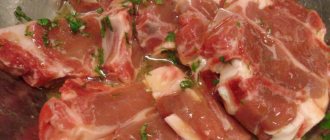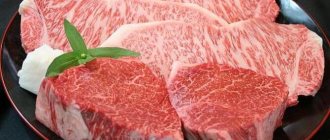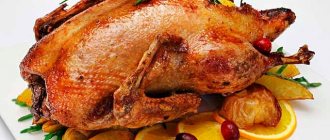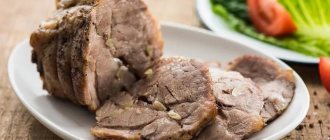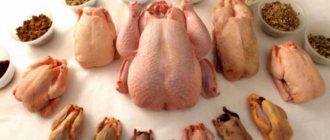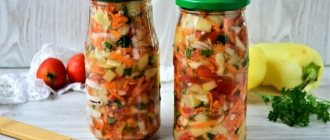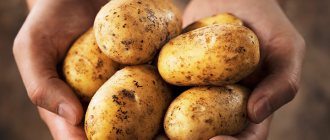When the question arises of choosing a healthy diet for a baby, every mother strives to give her child only the best, high-quality and healthy products at the beginning of his gastronomic journey. It’s great if the choice fell on rabbit meat. This meat has always been considered a coveted delicacy dish, along with the commonly available chicken or beef - tender, aromatic, it is a rare holiday guest both in the old days and on modern tables, and it’s very in vain - delicious meat will bring as much benefit as joy from the taste and aroma.
Meat is a new product in the diet
Protein is a building material for muscle tissue, so it is a necessary component of the diet of any person, especially a tiny one who still has time to grow. Many young parents are afraid to give meat too early, so it is always better to ask for advice from a doctor who observes the newborn and knows the peculiarities of its development. It is the doctor who decides where to start complementary feeding: for example, for children who are not gaining weight well, they are recommended to give porridge first. And babies who are actively growing and getting better are the first to try vegetables. Therefore, the choice of products depends on various factors.
Meat is usually offered to babies around 8 months. If the child is on artificial nutrition, and the first complementary foods were introduced at 4 months, then protein can be offered for about six months. They start cooking poultry first; it is advisable to choose turkey meat, since it, as a rule, does not cause allergies, unlike chicken meat. An alternative would be rabbit - a surprisingly gentle and safe product.
Rabbit meat: benefits and advantages
The cost of this meat usually deters parents. However, turkey is also not universally available, like veal. If you want to save money, you will have to choose chicken, but there is some risk in this decision. Taking into account the tiny portions that you will feed your baby for the first time, the expensive meat you buy will still last a long time, so is it worth saving on his health?
It should also be taken into account that choosing a rabbit for an infant means ensuring:
- sufficient amount of protein with minimal cholesterol;
- safe introduction of meat into the baby’s diet;
- easy digestibility and digestion of a heavy product;
- healthy development of the baby, because rabbit meat stimulates the development of the brain, bones, nails, and teeth formation due to the high phosphorus content.
Content
Introducing complementary foods for many parents is quite a difficult task, because you need to decide where to start, maintain a pause between new products, and monitor the baby’s reaction. But the most important thing is to choose safe and truly healthy foods. Among these is dietary meat: how do we cook baby rabbit? There are many answers to this question, because the dish should be tender and tasty.
Of course, at first you will have to cook the baby separately. This is a rather labor-intensive process, but it’s so nice to give your baby new tastes and impressions.
Rules for introducing rabbit meat
If the newborn is developing normally, doctors recommend introducing meat at about 8 months. Before this, his digestive system is not yet ready to digest the protein product. It is important that protein is not the first complementary food - usually it is cereal porridge or vegetables. Therefore, by the time meat dishes are introduced, the stomach and intestines are already prepared.
Like all foods, meat should be given a little at a time. First, literally a drop of it is added to the baby’s usual dish - vegetable puree or soup. You can give it separately - by mixing crumbs of the ground product with breast milk or formula. If there is no negative reaction, which may not occur immediately, but the next day, then the portion is gradually increased.
During the period of protein introduction, the portion weight is increased to 50 g. Up to a year, the portion of meat in the daily diet of the baby is no more than 70 g.
Canned meat: pros and cons
Manufacturers of baby food offer a wide range of canned food, both with pure rabbit meat and with a mixture of vegetables and protein products. Convenient small jars are easy to take on the road or even for a walk; you can use them for future use and not have to prepare the dish every day. But is it safe to use canned food even from leading baby food manufacturers?
- It is impossible to check the quality of meat, no matter what is written on the can. It is clear that the use of an expensive product will make canned food also inaccessible, which is not very profitable for manufacturers.
- Canned food usually contains starch and preservatives. Even if they are safe, they are completely unnecessary for your 8 month old baby.
- Violation of storage conditions that you cannot check before purchase leads to the fact that canned food may be unsafe.
Mom will be much calmer if she buys a rabbit herself, cuts it up and freezes it. It is not difficult to prepare, because it is important to offer the baby chopped and well-cooked meat.
Excerpts from baby food books about meat feeding:
Kid's Kitchen. 1988
Kid's Kitchen. 1988
Kid's Kitchen. 1988
Kid's Kitchen. 1988
Kid's Kitchen. 1988
“Handbook for parents. Feeding and feeding a child from 0 to 5 years old with love and common sense.” Ellyn Satter.
“Handbook for parents. Feeding and feeding a child from 0 to 5 years old with love and common sense.” Ellyn Satter.
“Handbook for parents. Feeding and feeding a child from 0 to 5 years old with love and common sense.” Ellyn Satter.
“Handbook for parents. Feeding and feeding a child from 0 to 5 years old with love and common sense.” Ellyn Satter.
“Handbook for parents. Feeding and feeding a child from 0 to 5 years old with love and common sense.” Ellyn Satter.
“Handbook for parents. Feeding and feeding a child from 0 to 5 years old with love and common sense.” Ellyn Satter.
We eat with gusto. Madeleine Denis. Click on me!!!
We eat with gusto. Madeleine Denis. Click on me!!
We eat with gusto.
Madeleine Denis. Click on me!! Happy weaning!
PS . I understand that I am writing late; many mothers who followed my schedule have already surpassed me. Please forgive me, for me January of every year is a special period of rethinking my life. I'll try to catch up with you in the near future. Ask questions, I will try to answer them all.
We are not afraid and add me to Odnoklassniki and Instagram!
Did you like the article? Subscribe to site updates
"Encyclopedia of Baby Food"!
Don't forget to bookmark us! (CTRL+SHiFT+D) Subscribe to the site, comment, share on social networks.
On our website Encyclopedia Baby Food there is useful information on the nutrition of your children, which is useful for everyone, and we update the Encyclopedia Baby Food website constantly and try to search and write only excellent, verified and necessary information for you and your children.
Disclaimer #1: It is necessary to understand that the author of the articles on the Encyclopedia Baby Food website is not a medical professional, “I am not a doctor.” The information I share is based on my own experience. My goal is not to teach you how to eat or feed your child, but to tell you about what we did, what new things I learned or read. This allows you to expand your knowledge about baby food, allows you to see the whole process so that you can decide whether you like it or whether it’s worth doing the same.
Disclaimer #2 : However, the above does not replace visiting your pediatrician. Before you start complementary feeding, you should seek his professional opinion on the best way to introduce new foods to your baby. Please also note that you need to look at the original date of published articles, as some “best practices” may have changed. Always consult your child's pediatrician about complementary feeding and his or her health.
Disclaimer #3: Keep in mind that every family is unique, and every situation is completely unique. There are no universal solutions. Only you can find what works best for you. Certain goals require certain sacrifices and priorities—not everyone wants to make those choices, and that's GREAT! Just know what you want to achieve and be ready to get to work doing your best!
Disclaimer No. 4: The Encyclopedia Baby Food website uses photos from books on baby food with attribution for a more complete understanding of the information (Article 1274, paragraph 1, part four of the Civil Code of the Russian Federation). Literature on baby nutrition was found freely available on the Internet.
Apricot puree with chicken Banana-apple puree Banana puree Borscht Broth with peas and rice Kohlrabi sandwich Quick dessert made from ready-made dough Zucchini jam with strawberries Buckwheat with green peas Buckwheat porridge Buckwheat porridge with apricots Buckwheat porridge with banana Buckwheat pilaf Children's sausage Children's milk porridge with banana Children's vinaigrette Children's ketchup Children's cucumber salad Children's Olivier salad Children's porridge cookies Children's puree of strawberries, banana, yellow cherries, matsoni and cookies with cereals Children's puree with cottage cheese and fruit Homemade yeast bread with flaxseed flour Homemade pizza Breakfast on the street Snack from kohlrabi Baking cauliflower Baked carrots Baked carrots and cherries with millet Winter salad with Jerusalem artichoke Cabbage with white beans Cabbage salad as in the cafeteria Mashed potatoes Quinoa and pumpkin porridge Porridge Quinoa porridge for breakfast Quinoa and apple Strawberry puree Strawberry puree with banana Strawberry compote Compote from wild apples and raspberries Compote of dried fruits steamed in a thermos" for a child over 8 months Corn porridge Corn porridge with pear Corn porridge with pumpkin Corn porridge with pumpkin and carrots Corn porridge with apple and carrots Chicken cutlets with carrots Chicken with carrots, sweet peppers and potatoes Navy-style pasta Pasta with orange sauce Milk noodle soup Carrot and potato puree Carrot and rice casserole Carrots with chicken Fly agarics made from eggs and tomatoes Vegetable puree from cauliflower and carrots Vegetable soup with corn semolina Vegetable soup with cheese and corn semolina Vegetable cream soup with bell pepper Oatmeal Pancakes with hot kefir Omelette in a bag Omelette with broccoli and cauliflower Omelette pancake Peach puree Baked apples 7 months + Zucchini and carrot pie Zucchini pie Rice and zucchini pie White cabbage pizza Rabbit pilaf Chicken pilaf with green peas and corn Banana and cherry puree Banana, cottage cheese and porridge puree 4 grains Broccoli (cauliflower) puree Broccoli, zucchini and cauliflower puree Blueberry puree Pear puree Pear and banana puree pear and banana, baking Pear and pumpkin puree 7 months + Pear, pumpkin and peach puree Pear, apple, plum and prune puree Turkey puree Zucchini puree Zucchini and broccoli puree Zucchini, carrot and potato puree Quinoa puree and banana Quinoa and carrot puree Quinoa, banana and carrot puree Quinoa, zucchini and carrot puree Quinoa, peach and raspberry puree Quinoa, cauliflower, apple, pea and mint puree Quinoa, apple, pear and raisin puree quinoa, apple, carrot puree rabbit, broccoli and cauliflower puree chicken, carrot, potato, apple and pea puree raspberry, cherry and banana puree carrot puree carrot and apple puree carrot, potato, broccoli puree with cheese puree from carrots, potatoes, apples and quinoa Carrot, pumpkin, apple and prune puree Carrot, apple and potato puree Turnip and carrot puree Plum puree Cottage cheese, strawberry and banana puree Pumpkin puree Pumpkin and banana puree Pumpkin puree and zucchini Pumpkin and apple puree Pumpkin, apple and banana puree Cauliflower and broccoli puree Cauliflower and potato puree Cauliflower and rice puree Cauliflower and apple puree Cauliflower, green pea and zucchini puree Cauliflower puree cabbage, turkey and potatoes pureed cauliflower, potatoes and zucchini pureed cauliflower, carrots and broccoli pureed cauliflower, carrots, cheese and rice pureed cauliflower, apples and zucchini pureed zucchini pureed zucchini and potatoes pureed zucchini , carrots and apples Cherry puree Blueberry puree Prune puree Apple, pumpkin, carrot puree and a little curry Apple and pear puree Apple and strawberry puree Apple, strawberry and cherry puree Apple, peach and banana puree Carrot puree with pumpkin Cottage cheese and banana puree Turkey, potato and carrot ragout Zucchini, carrot and broccoli ragout Fish, potato, carrot and broccoli ragout Rice porridge Whole grain rice porridge Rice porridge with carrots Rice porridge with pumpkin Rice porridge with apples Rice porridge with apple and pear Rice porridge with apple and pumpkin Fish cutlets with vegetables Semi-finished fish Fish balls with ketchup Fish soup for children Fish soup with salmon and celery Carrot and kohlrabi salad Chickpea salad The laziest soup Creamy kohlrabi puree soup Smoothie with oatmeal One Pot Sauce Pea and Bacon Soup Roasted Vegetable Soup Kohlrabi Soup Salmon Soup Cauliflower Soup Potato and Turnip Soup Meatball Soup for the Picky Eater Cream of Rabbit, Pumpkin, Potato, Broccoli and Cauliflower Soup Cream of Soup beets Pumpkin puree soup with mushrooms Broccoli and celery puree soup Pork soup/stew with potatoes and carrots Cheese pasties Pumpkin cheese sauce (Annabelle Carmel's recipe) Pumpkin-apple puree Pumpkin-apple juice Pumpkin cake Pumpkin puree soup Fruit salad Fruit salad with mango Bread lavash Cauliflower with cheese Linden and thyme tea Experimental puree soup with noodles and lentils Applesauce Apple juice
Rabbit recipes for baby
Traditionally, the baby is offered soup or puree with meat.
- The most delicate option would be puree:
- A piece of meat can be soaked overnight, then in the morning it will be more tender and softer.
- The next day, the meat is cut into small pieces and boiled. It is important to boil the rabbit in the second water: when the first broth boils, drain it and pour in clean cold water.
- This product is cooked for 40 to 90 minutes.
- Using a blender, grind the meat into puree. To do this, you need to add a little water to the meat to make the mass tender. If you grind the rabbit in a meat grinder, you should pass it twice and then lightly beat it with warm water.
- The baby should be fed slightly cooled puree - to about room temperature. You can add it to the vegetable mixture or try it separately.
- Soups are prepared using vegetables that your baby has already tried. To prepare liquid dishes, you need to take the meat and boil it in the same way as described above. After the rabbit is almost ready, potatoes and other vegetables are added to the broth. As a rule, these are onions, carrots, cabbage. You can add salt to the soup, otherwise the dish will be tasteless, and the baby simply will not want to eat it. If you do not have teeth or the ability to chew, the soup should be crushed.
- Another delicious option for preparing rabbit is soufflé. Adults will also like it, the dish is so tender. You can cook it in a slow cooker or in the oven. To do this, take 300-500 g of boneless meat, grind it into minced meat, add a couple of quail eggs or a couple of yolks from chicken eggs. For older children, add the pulp of a white loaf (about two slices) and ½ glass of age-appropriate milk. You can add pureed pumpkin or carrots instead, or along with the milk and bread. If the baby is still quite small, then you can first boil the vegetables, chop them and then add them to the minced meat (by the way, you can also boil the meat first). The thoroughly mixed mass is placed in a mold and baked in a convenient manner for about half an hour. Soufflé is a tender alternative to cutlets, which babies are unlikely to be able to chew yet.
Rabbit meat is a healthy dietary product that can be called optimal for introducing protein into a baby’s diet. When preparing it yourself, you can eliminate the risk of infection, the influence of preservatives and products that the baby does not need at all. Of course, the rabbit is boiled and baked for quite a long time, but it allows you to feed the baby a delicious and tender dish with a lot of useful properties.
Cooking rabbit meat for the baby
Observe the following rules when cooking meat:
- Use only fresh product. If there is such an opportunity, it is better to purchase a rabbit raised in the village rather than bought in a supermarket.
- During cooking, it is worth immersing the meat in boiling water.
- Before cooking, any remaining fat accumulations should be trimmed from the carcass.
- For children under one year old, meat should be cut across the grain. It must be remembered that after the product is crushed, you should not wash it.
- It is better to steam or bake rabbit meat. This way you can save more nutrients than after cooking.
- To get juicy and soft boiled meat, you need to soak it in water for two hours in advance.
- How long to cook a rabbit for feeding depends on how young the meat is. For your baby, try to buy young specimens. The older the meat, the longer it will take to cook. But it should be cooked for at least an hour . It is better to check its readiness by piercing it with a fork.
- If you use frozen rabbit meat, you should defrost it before cooking. To do this, wrap the meat in a paper towel to remove excess moisture. Leave to melt at room temperature. When the rabbit meat has melted, rinse and dry it.
